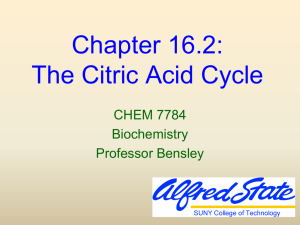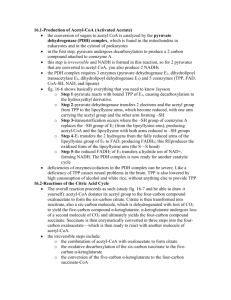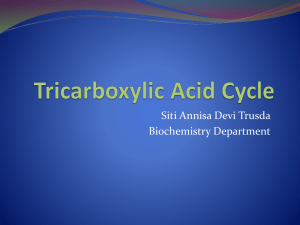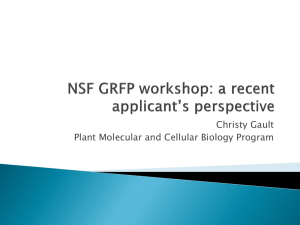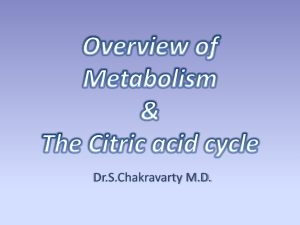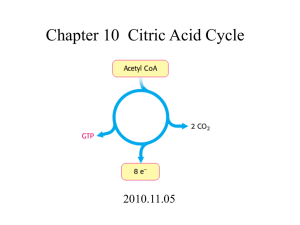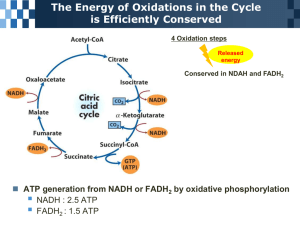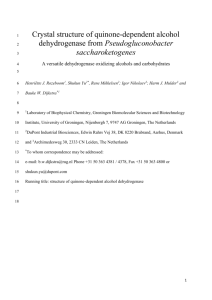Citric Acid Cycle Cycle Overview Metabolic Sources of Acetyl
advertisement
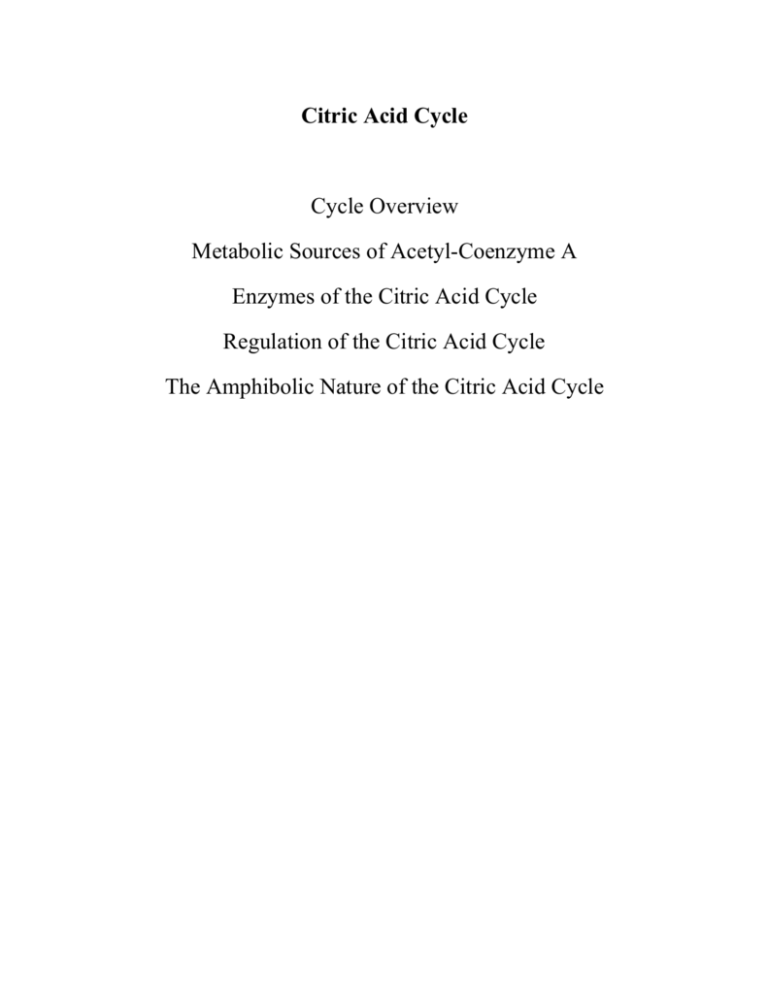
Citric Acid Cycle Cycle Overview Metabolic Sources of Acetyl-Coenzyme A Enzymes of the Citric Acid Cycle Regulation of the Citric Acid Cycle The Amphibolic Nature of the Citric Acid Cycle Cycle Overview (citric acid or Krebs or tricarboxylic acid cycle) Amphibolic - operates catabolically and anabolically acetyl group → 2CO2 Reactions of the cycle: 1. 2. 3. 4. 5. 6. 7. 8. Citrate synthase Aconitase Isocitrate dehydrogenase α-Ketoglutarate dehydrogenase Succinyl-CoA synthase Succinate dehydrogenase Fumarase Malate dehydrogenase 3NAD+ + FAD + GDP + Pi + acetyl-CoA → 3NADH + FADH2 + GTP + CoA + 2CO2 Cycle operates catalytically as a result of regeneration of oxaloacetate Acetyl-Coenzyme A (acetyl-SCoA or acetyl-CoA) common product of carbohydrate, fatty acid and amino acid breakdown (∆G˚' = -31.5 kJ.mol-1) Metabolic Sources of Acetyl-Coenzyme A Pyruvate + CoA + NAD+ → acetyl-CoA + CO2 + NADH Pyruvate dehydrogenase multienzyme complex pyruvate dehydrogenase (E1) dihydrolipoyl transacetylase (E2) dihydrolipoyl dehydrogenase (E3) Eukaryotic complex - 30 E1 dimers + 6 E3 dimers around a core of 60 E2 monomers Advantages of multienzyme complexes: 1. Rate enhancement due to shorter distances for diffusion of substrates 2. Channeling of intermediates, minimized side reactions 3. Coordinate control of reactions Five cofactors required: thiamine pyrophosphate (TPP) lipoic acid coenzyme A (CoA) flavin adenine dinucleotide (FAD) nicotinamide adenine dinucleotide (NAD+) Metabolic Sources of Acetyl-Coenzyme A Pyruvate dehydrogenase multienzyme complex Five reactions: 1. Pyruvate dehydrogenase (E1) decarboxylates pyruvate (identical to pyruvate decarboxylase) 2. Hydroxylethyl group transferred to E2 3. E2 catalyzes transfer (transesterification) of acetyl group to CoA 4. Dihydrolipoyl dehydrogenase (E3, lipoamide dehydrogenase) reoxidizes dihydrolipoamide (similar to glutathione reductase reaction in reverse) 5. Reduced E3 reoxidized by NAD+ Metabolic Sources of Acetyl-Coenzyme A Pyruvate dehydrogenase multienzyme complex Dihydrolipoyl transacetylase (E2): lipoyllysyl tether allows one E1 subunit to acetylate many E2 subunits and one E3 subunit can reoxidize several dihydrolipoamide groups Arsenic compounds covalently bind sulfhydryl groups, inactivates lipoamide-containing enzymes (pyruvate dehydrogenase and α-ketoglutarate dehydrogenase) Protein X - facilitates binding of dihydrolipoyl dehydrogenase (E3) Control of Pyruvate Dehydrogenase Pyruvate dehydrogenase (E1) Product inhibition by NADH and acetyl-CoA NADH and acetyl-CoA compete with NAD+ and CoA Drive reversible E2 and E3 reactions backwards Covalent modification by phosphorylation/dephosphorylation pyruvate dehydrogenase kinase - inactivates E1 subunit by phosphorylating Ser residue pyruvate dehydrogenase phosphatase -reactivates E1 subunit by dephosphorylating Ser residue Enzymes of the Citric Acid Cycle Citrate synthase acetyl-CoA + oxaloacetate → CoA + citrate Ordered sequential mechanism - oxaloacetate adds first His274, Asp375, and His320 general acid-base catalysis Rate determining step - formation of enol form of acetylCoA Formation of enzyme-bound citryl-CoA Hydrolysis of citryl-CoA to citrate and CoA ∆G˚' = -31.5 kJ.mol-1 Stereospecific Aldol-Claisen condensation at the si face Enzymes of the Citric Acid Cycle Aconitase citrate ⇔ aconitate ⇔ isocitrate Prochiral center First stage - dehydration reaction (trans elimination) Second stage - rehydration reaction (stereospecific trans addition) Asp, His, and Ser catalytic residues [4Fe-4S] iron sulfur cluster 180˚ flip of aconitate intermediate Enzymes of the Citric Acid Cycle NAD+-dependent isocitrate dehydrogenase isocitrate + NAD+ → α-ketoglutarate + CO2 + NADH First production of CO2 and NADH Requires Mn2+ or Mg2+ cofactor Enzymes of the Citric Acid Cycle α-Ketoglutarate dehydrogenase multienzyme complex α-ketoglutarate + acetyl-CoA + NAD+ → succinyl-CoA + CO2 + NADH + H+ α-ketoglutarate dehydrogenase (E1) dihydrolipoyl transsuccinylase (E2) dihydrolipoyl dehydrogenase (E3) Similar to pyruvate dehydrogenase complex (2-keto-acid dehydrogenase family) No covalent modification system Formation of "high-energy" thioester Enzymes of the Citric Acid Cycle Succinyl-CoA synthetase (succinate thiokinase) succinyl-CoA + GDP + Pi → succinate + CoA + GTP Phosphoryl-enzyme intermediate (OPO3-His) Successive synthesis of "high-energy" compounds: succinyl phosphate 3-phosphohistidine residue GTP Up to this point: one acetyl → 2CO2 + 2NADH + GTP(ATP) Enzymes of the Citric Acid Cycle Succinate dehydrogenase succinate + FAD → fumarate + FADH2 Stereospecific Bound to inner-mitochondrial membrane (only citric acid cycle enzyme membrane bound) FAD covalently linked to enzyme, reoxidized by electron transport chain Enzymes of the Citric Acid Cycle Fumarase fumarate + H2O → S-malate Hydration reaction Two possible mechanisms: carbocation intermediate carbanion intermediate - established by 18O exchange experiments, product release is rate determining step Enzymes of the Citric Acid Cycle Malate dehydrogenase S-malate + NAD+ → oxaloacetate + NADH + H+ ∆G˚' = +29.7 kJ.mol-1 [oxaloacetate] kept low (high ∆G˚' of citrate synthase drives cycle 1st reaction) Oxidation-reduction reaction Similar to lactate dehydrogenase and alcohol dehydrogenase Enzymes of the Citric Acid Cycle Integration of the citric acid cycle One cycle: 1. One acetyl oxidized to two CO2 (8 e- process) 2. Three NAD+ reduced to NADH (6 e-) 3. One FAD reduced to FADH2 (2 e-) 4. One GTP (ATP) produced Electrons pass to the electron transport chain O2 → H2O (4 e- process) NADH ≅ 3 ATP FADH2 ≅ 2 ATP one cycle ≅ 12 ATP These are approximate (maximum) number of ATP as we shall soon see Regulation of the Citric Acid Cycle Rate-controlling enzymes: citrate synthase isocitrate dehydrogenase α-ketoglutarate dehydrogenase Dioxygen consumption, NADH reoxidation, and ATP production are tightly coupled Regulatory control: 1. Substrate availability - oxaloacetate stimulates citrate synthase 2. Product inhibition - citrate competes with oxaloacetate for citrate synthase, NADH inhibits isocitrate dehydrogenase and α-ketoglutarate dehydrogenase, succinyl-CoA inhibits α-ketoglutarate dehydrogenase 3. Competitive feedback inhibition - NADH inhibits citrate synthase, succinyl-CoA competes with acetyl-CoA in citrate synthase reaction Most crucial regulators: substrates -acetyl-CoA and oxaloacetate product - NADH Regulation of the Citric Acid Cycle Allosteric control of cycle enzymes: isocitrate dehydrogenase α-ketoglutarate dehydrogenase pyruvate dehydrogenase phosphatase ADP - allosteric activator of isocitrate dehydrogenase ATP - inhibits isocitrate dehydrogenase Ca2+ - activates pyruvate dehydrogenase phosphatase, isocitrate dehydrogenase, α-ketoglutarate dehydrogenase The Amphibolic Nature of the Citric Acid Cycle Amphibolic - both anabolic and catabolic intermediates must be replaced Pathways that utilize citric acid cycle intermediates: 1. Glucose biosynthesis (gluconeogenesis) - oxaloacetate (transported as malate) 2. Lipid biosynthesis - acetyl-CoA from ATP-citrate lyase ATP + citrate + CoA ⇔ ADP + Pi + oxaloacetate + acetyl-CoA 3. Amino acid biosynthesis - α-ketoglutarate (glutamate dehydrogenase or transamination) and oxaloacetate (transamination) 4. Porphyrin biosynthesis - succinyl-CoA The Amphibolic Nature of the Citric Acid Cycle Reactions that replenish citric acid cycle intermediates: anaplerotic "filling up" reactions Pyruvate carboxylase Pyruvate + CO2 + ATP + H2O ⇔ oxaloacetate + ADP + Pi Oxidation of fatty acids - succinyl-CoA Breakdown of amino acids (Ile, Met, Val) - succinyl-CoA Transamination and deamination of amino acids - αketoglutarate and oxaloacetate
